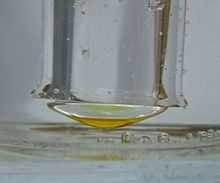Nitrogen trichloride
| Nitrogen trichloride | |
|---|---|
 |
 |
| Other names Trichloramine | |
| Identifiers | |
| CAS number | 10025-85-1 |
| PubChem | 61437 |
| ChemSpider | 55361 |
| ChEBI | CHEBI:37382 |
| RTECS number | QW974000 |
| Jmol-3D images | Image 1 |
| |
| |
| Properties | |
| Molar mass | 120.365 g/mol |
| Appearance | yellow oily liquid
 Nitrogen trichloride |
| Density | 1.635 g/mL |
| Melting point | −40 °C; −40 °F; 233 K |
| Boiling point | 71 °C; 160 °F; 344 K |
| Solubility in water | Immiscible slowly decomposes |
| Solubility | soluble in benzene, chloroform, CCl4, CS2, PCl3 |
| Structure | |
| Crystal structure | rhombohedral (below −40 °C) |
| Molecular shape | trigonal pyramidal |
| Dipole moment | 0.6 D |
| Thermochemistry | |
| Std enthalpy of formation ΔfH |
+232 kJ/mol |
| Standard molar entropy S |
? J.K−1.mol−1 |
| Hazards | |
| EU classification | not listed |
| NFPA 704 |
 0
2
4
OX
|
| Autoignition temperature | 93 °C |
| Related compounds | |
| Other anions | Nitrogen trifluoride Nitrogen tribromide Nitrogen triiodide |
| Other cations | Phosphorus trichloride Arsenic trichloride |
| Related chloramines | Chloramine Dichloramine |
| Related compounds | Nitrosyl chloride |
| Except where noted otherwise, data are given for materials in their standard state (at 25 °C (77 °F), 100 kPa) | |
| Infobox references | |
Nitrogen trichloride, also known as trichloramine, is the chemical compound with the formula NCl3. This yellow, oily, pungent-smelling liquid is most commonly encountered as a byproduct of chemical reactions between ammonia-derivatives and chlorine (for example, in swimming pools).
Preparation and structure
The compound is prepared by treatment of ammonium salts, such as ammonium nitrate with chlorine:
Intermediates in this conversion include chloramine and dichloramine, NH2Cl and NHCl2, respectively.
Like ammonia, NCl3 is a pyramidal molecule. The N-Cl distances are 1.76 Å, and the Cl-N-Cl angles are 107°.[1]
Nitrogen trichloride can form in small amounts when public water supplies are disinfected with monochloramine, and in swimming pools by disinfecting chlorine reacting with urea in urine from bathers. Nitrogen trichloride, trademarked as Agene, was used to artificially bleach and age flour, but was banned in 1949: Dogs that ate bread made from treated flour suffered epileptic-like fits; the toxic agent was methionine sulfoxide.
Reactions
Despite the similarities of the Pauling electronegativities of nitrogen and chlorine, this molecule has moderate polarity with negative charges residing on nitrogen. So the nitrogen in NCl3 is often considered to have the −3 oxidation state and the chlorine atoms are considered to be in the +1 oxidation state.
It is hydrolyzed by hot water to release ammonia and hypochlorous acid.
- NCl3 + 3 H2O → NH3 + 3 HOCl
Safety
Nitrogen trichloride can irritate mucous membranes—it is tear gas, but has never been used as such.[2][3] The pure substance (rarely encountered) is a dangerous explosive, being sensitive to light, heat, even moderate shock, and organic compounds. Pierre Louis Dulong first prepared it in 1812, and lost two fingers and an eye in two explosions. An NCl3 explosion blinded Sir Humphry Davy temporarily, inducing him to hire Michael Faraday as a co-worker.
In 2006, Belgian researchers reported a possible link between NCl3 and rising numbers of childhood asthma cases, in what they call the pool chlorine hypothesis, as an alternative to the hygiene hypothesis with a closer causal link.[4]
References
- ↑ Holleman, A. F.; Wiberg, E. (2001). Inorganic Chemistry. San Diego: Academic Press. ISBN 0-12-352651-5.
- ↑ White, G. C. (1999). The Handbook of Chlorination and Alternative Disinfectants (4th ed.). Wiley. p. 322. ISBN 978-0-471-29207-4.
- ↑ "Health Hazard Evaluation Report: Investigation of Employee Symptoms at an Indoor Water Park" (pdf). NIOSH eNews (National Institute for Occupational Safety and Health) 6 (4). August 2008. HETA 2007-0163-3062.
- ↑ Bernard, A.; Carbonnelle, S.; de Burbure, C.; Michel, O.; Nickmilder, M. (2006). "Chlorinated Pool Attendance, Atopy, and the Risk of Asthma During Childhood" (pdf). Environmental Health Perspectives 114 (10): 1567–1573. doi:10.1289/ehp.8461. PMC 1626429. PMID 17035144.
Further reading
- Jander, J. (1976). "Recent Chemistry and Structure Investigation of Nitrogen Triiodide, Tribromide, Trichloride, and Related Compounds". Advances in Inorganic Chemistry 19: 1–63. doi:10.1016/S0065-2792(08)60070-9.
- Kovacic, P.; Lowery, M. K.; Field, K. W. (1970). "Chemistry of N-Bromamines and N-Chloramines". Chemical Reviews 70 (6): 639–665. doi:10.1021/cr60268a002.
- Hartl, H.; Schöner, J.; Jander, J.; Schulz, H. (1975). "Die Struktur des Festen Stickstofftrichlorids (−125 °C)". Zeitschrift für Anorganische und Allgemeine Chemie 413 (1): 61–71. doi:10.1002/zaac.19754130108.
- Cazzoli, G.; Favero, P. G.; Dal Borgo, A. (1974). "Molecular Structure, Nuclear Quadrupole Coupling Constant and Dipole Moment of Nitrogen Trichloride from Microwave Spectroscopy". Journal of Molecular Spectroscopy 50 (1–3): 82–89. doi:10.1016/0022-2852(74)90219-7.
- Bayersdorfer, L.; Engelhardt, U.; Fischer, J.; Höhne, K.; Jander, J. (1969). "Untersuchungen an Stickstoff–Chlor-Verbindungen. V. Infrarot- und RAMAN-Spektren von Stickstofftrichlorid". Zeitschrift für Anorganische und Allgemeine Chemie 366 (3–4): 169–179. doi:10.1002/zaac.19693660308.